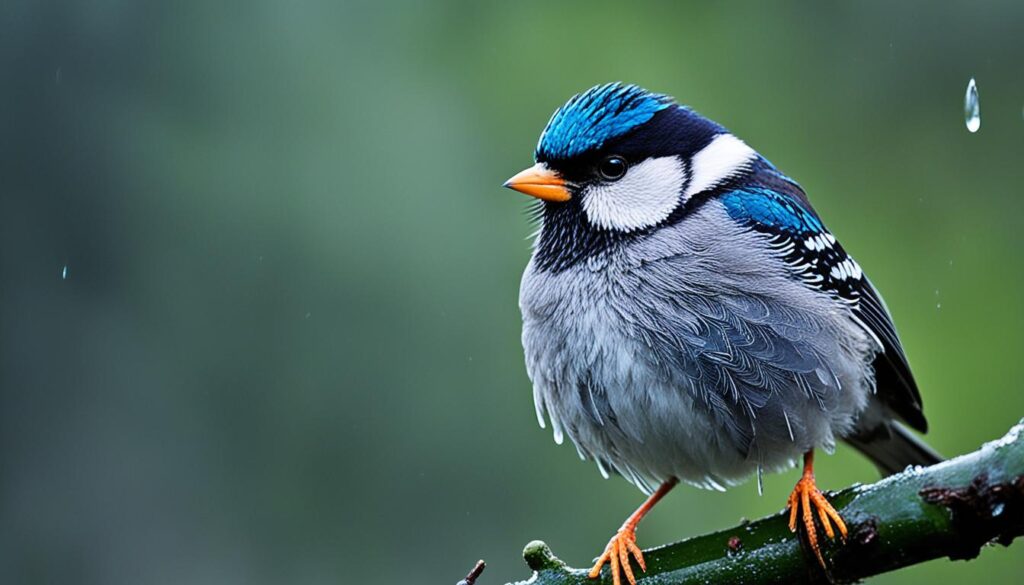When spring showers come, a songbird finds a spot to sit, its feathers shining with raindrops. Birds have learned to handle the rain well. They find shelter in thick leaves or preen their feathers to stay dry.
Key Takeaways
- Birds have various adaptations to stay dry in the rain, such as waterproof feathers and oil glands.
- Many birds seek shelter in dense vegetation or man-made structures to avoid getting wet.
- Larger birds like gulls and hawks often wait out heavy rain by sitting still, while smaller songbirds find protected spots under branches or in cavities.
- Urban birds may take refuge in porches, sheds, and other human-made structures during rainstorms.
- Birds in rainy climates have developed specialized behaviors to cope with frequent precipitation.
Bird Behavior During Rainfall
When it rains, birds have many ways to stay dry and cozy. They use their waterproof feathers and preen glands for protection. But they often stay on the ground during heavy rain to save energy.
Adaptations for Staying Dry
Birds have smart ways to stay dry. They fluff up their feathers to keep warm and dry. Or they look for shelter in trees and bushes. Big birds like gulls, hawks, and pigeons just wait it out. Smaller songbirds find hidden spots to save energy.
Seeking Shelter in Trees and Shrubs
Birds quickly find shelter when it rains. Trees and shrubs protect them from the rain. Birds that live in trees or open areas look for shelter too. Most birds know to find these spots to stay dry.
After the rain stops, birds come out to look for food. Some waterfowl like ducks forage in the rain. But most birds wait in their shelters until the rain stops.
Where Do Birds Go for Shelter When It Rains?
When it rains, birds use different ways to stay dry and safe. Their methods vary by size and where they live. Larger birds like gulls and hawks might stay out in the open. Smaller birds hide under thick leaves, tree trunks, and overhangs. In cities, birds may hide in places made by humans, like porches and sheds.
Birds in rainy places often keep doing what they normally do, except when it rains too hard. Birds that live in small spaces, like chickadees and owls, stay inside during storms. But, big birds like hawks can’t fly well when their feathers get wet from heavy rain.
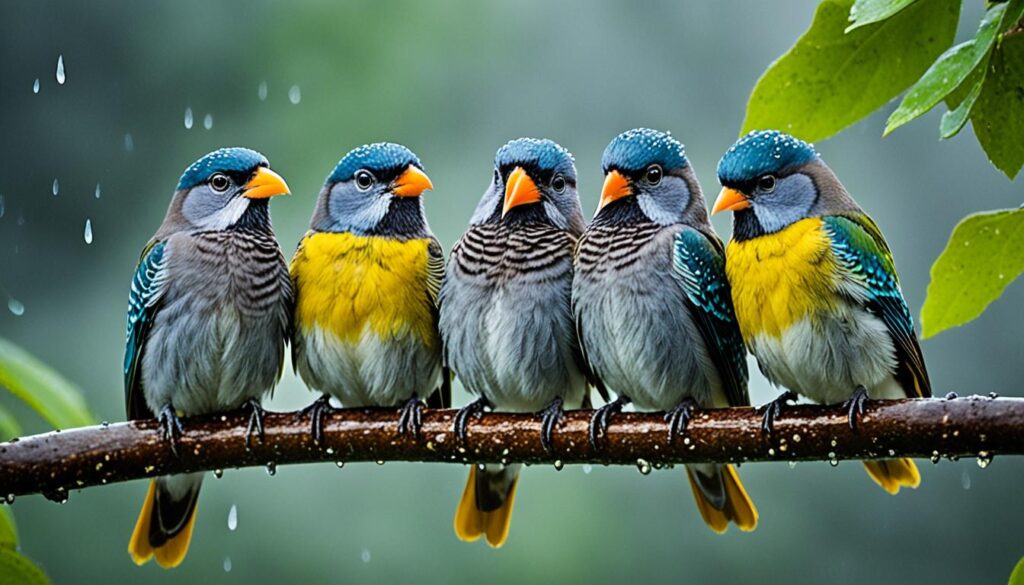
Seabirds like albatrosses and gulls can fly in strong winds but go back to land or find calmer spots in bad storms. Small songbirds, including robins and thrushes, go out in the rain to find worms to eat. Ducks and herons do well in heavy rain, finding new places to look for food.
“Birds are experts at following weather patterns and can sense changes in barometric pressure when a storm is coming.”
Birds, no matter their size or where they live, have many ways to stay safe from the rain. Learning about how they handle the rain helps us see how tough and adaptable they are.
Large Birds vs. Small Songbirds
Birds react differently to rain based on their size and where they live. Big birds like gulls, hawks, and pigeons just stay put in the rain. Their thick feathers and size protect them from the cold and rain. On the other hand, small songbirds find shelter under trees or in dense foliage to stay dry and save energy.
Gulls, Hawks, and Pigeons Endure Rain
Gulls, hawks, and pigeons are well adapted to rain. Their thick feathers and big size keep them warm. They can fly and find food even when it’s raining. You might see them waiting out the storm on tree tops or buildings.
Songbirds Seek Covered Spots
Small birds like songbirds have a harder time in the rain. They lose heat fast and can get cold quickly. So, they look for shelter like thick bushes or under tree branches to stay warm and save energy.
The rain’s intensity affects how birds react. Light rain might not be a big deal, but heavy rain makes more birds seek shelter. In heavy rain, birds may flatten their feathers and tuck their heads to help raindrops slide off.
“Birds observed in the field tend to reappear after briefly disappearing when rain starts, indicating they can’t afford to stop foraging, especially if they have young chicks to feed.”
Birds’ responses to rain depend on their size, where they live, and the weather. Learning about their ways helps us see how tough and clever they are in bad weather.
Urban Birds and Shelters
When it rains, birds in cities and suburbs find shelter in buildings and trees. These urban birds, like pigeons and sparrows, hide under porches and sheds. These spots are common in cities.
Forests and wetlands are key shelters for many birds. But cities and suburbs offer more places for birds to hide from the rain. This helps urban birds survive bad weather better.
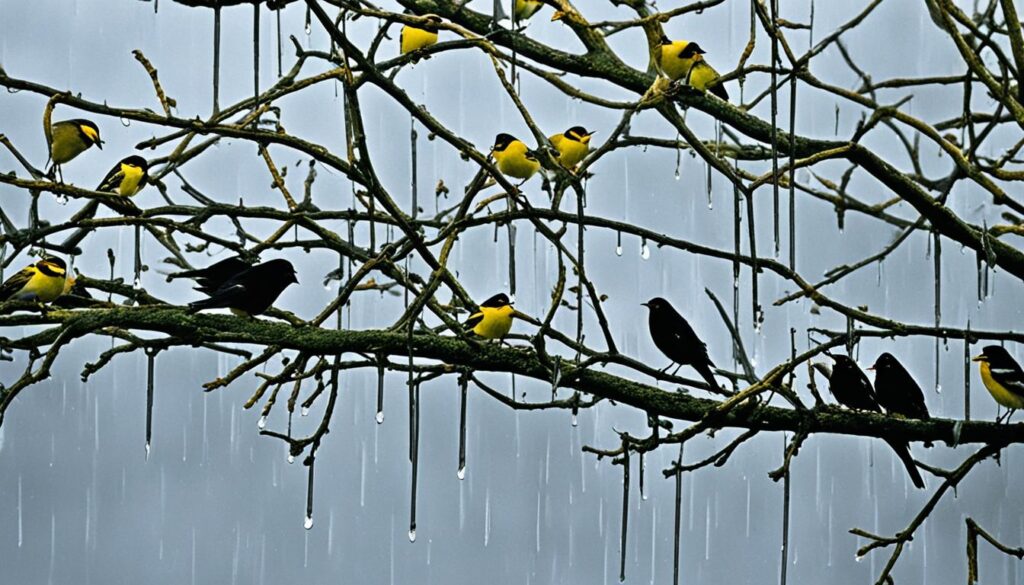
Birds use city shelters to stay dry and warm. This keeps their feathers from getting wet and keeps them from getting cold. Many city birds have learned to live well in these places.
Birds in Rainy Climates
Birds in rainy areas get used to the rain. They may hide when it pours, but they keep up their usual activities in light rain. They have special ways to handle the wet weather.
Small birds have it tough in the rain. They lose heat fast because they are small and have a lot of surface area. To stay warm and dry, they make waterproof oils and use air pockets under their wings for insulation.
- Small birds have smaller energy reserves and a higher surface-to-volume ratio than larger birds, making them more susceptible to heat loss in rainy conditions.
- Birds have highly waterproof feathers that protect them from rain; most water will roll off their feathers, and they can produce oil to further protect themselves from the rain.
- Birds have evolved specialized air pockets under their wings, acting as insulation similar to down coats.
Birds in rainy places have learned to live with the rain. They hide in safe spots during bad weather to stay warm and safe from predators. But, they still go out to find food and do their daily stuff when it’s just raining a bit.
“A 2010 study found that rain causes stress to birds, with researchers in a Costa Rican rainforest discovering higher levels of a stress hormone in birds on rainy days.”
Even though rain is hard on birds, those in wet places have found ways to deal with it. By learning how birds cope with rain in wet regions, we see how amazing they are. They show us how to adapt and survive in avian rain adaptations in high precipitation areas and bird behavior during chronic rainfall.
What do birds do when it storms?
When a storm comes, birds can feel the air pressure changing before the storm hits. This makes them act on instinct to get ready. They look for signs in their environment and start to forage more. Birds use different strategies to survive the storm.
Recognizing Changes in Air Pressure
Birds can sense small changes in air pressure, which tells them a storm is coming. When the pressure goes down, they get restless and start making more noise. This means they’re getting ready for the storm.
Foraging Before Storms
Before the storm hits, many birds start to forage more. They gather extra food because they know the storm might make it hard to find food later. This way, they’re prepared for the tough times ahead.
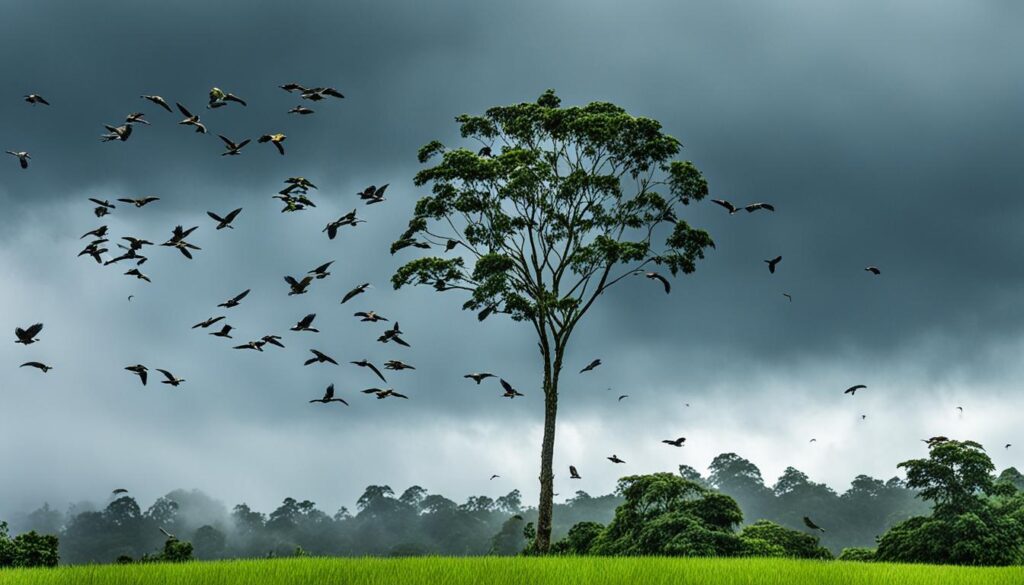
Birds act in ways that help them get ready for the storm. They use their sharp senses and survival instincts to deal with the storm’s high winds and heavy rain. These actions increase their chances of making it through the storm.
Storm Shelter for Birds
When storms hit, birds look for the safest spots, like thick shrubs and dense thickets. These places let them hide and save energy until the storm gets weaker. They also seek shelter on the downwind side of woods and forests, where trees and leaves protect them from wind and rain.
Dense Shrubs and Thickets
Birds head to areas with the thickest vegetation during bad weather. Thick shrubs and thickets give them great protection from wind, rain, and snow. By hiding in these spots, birds can stay safe and save energy until the weather gets better.
Downwind Side of Woods and Forests
Besides dense shrubs, birds also find shelter on the downwind side of woods and forests. The trees and leaves there block the wind and rain, making a safe spot for birds. This shelter keeps them dry and comfortable until the storm ends.
Knowing where birds take shelter during storms helps us understand how they survive bad weather. By creating safe spots in our yards, we can help local birds during tough times.
Cavity-Nesting Birds During Storms
Birds like chickadees, small owls, and woodpeckers nest in cavities. This gives them a big advantage during storms. They can hide in their nest holes or roost boxes, keeping safe from high winds and heavy rain.
Storms can be tough for birds. They can destroy nests, flood nests on the ground, and make finding food hard. But, cavity-nesting birds stay safe in their nests. This helps them save energy and stay dry during bad weather.
- Cavity-nesting birds like chickadees may roost in their nest cavities during winter nights.
- Wet feathers can make it hard for birds to fly, so they seek shelter in hedges, shrubbery, or up trees during bad weather.
- Birds tend to hunker down during storms, behaving similarly to humans by seeking refuge from the harsh conditions.
These birds can sense when a storm is coming. They look for changes in temperature, wind speed, and air pressure. Before the storm hits, they eat a lot to have energy for the storm.
“Storms can directly kill cavity-nesting birds through floods, collisions with obstacles, or getting buried under debris.”
Even with their advantages, cavity-nesting birds are not safe from storms. Some birds might change their migration plans because of the storm. Also, storms can flood valleys, change shorelines, or knock down trees, making it harder for these birds to find places to nest.
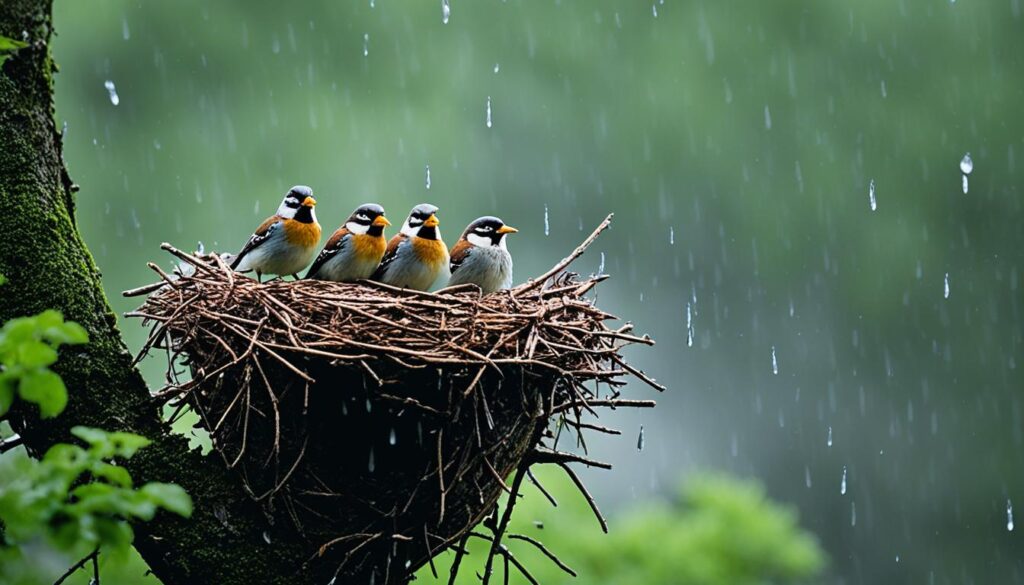
The shelter provided by cavities, nests, and roost boxes is key for cavity-nesting birds to survive storms. Learning about their strategies and adaptations helps us see how important they are to the ecosystem, even in tough weather.
Providing Protection for Birds
Homeowners and gardeners can make their yards safer for birds during storms. By adding dense, native plants like evergreen shrubs and trees, you help birds find shelter. These plants should be grouped together to create a safe space for birds in the rain.
Native Plants for Shelter
Using native plants is a smart way to make your yard bird-friendly. Plants like juniper, holly, and red cedar have thick leaves that protect birds from wind and rain. These evergreens give birds a safe spot all year, helping them stay dry and warm.
Grouping Shrubs Together
When designing your garden, put shrubs and trees close together. This makes a safe, layered shelter for birds. Birds can easily find cover among the dense foliage, staying safe from the storm.
“Providing a diverse array of native plants, both evergreen and deciduous, is key to creating a bird-friendly landscape that offers reliable shelter during inclement weather.”
Importance of Dead Trees and Snags
Many think dead trees are useless, but they’re actually great for birds and wildlife. These trees, or snags, slowly break down and lose branches. This creates hiding spots and nests for many birds.
Woodpeckers also make homes in these trees, giving even more shelter during bad weather. So, dead trees help birds stay safe and dry.
More than 80 bird species and over 100 animals use dead trees for homes, food, and places to hunt. Even in cities, these trees can become homes for creatures like dragonflies and young bald eagles.
- Dead trees and snags provide nesting cavities for woodpeckers, owls, chickadees, bluebirds, titmice, wrens, nuthatches, wood ducks, and more.
- Decaying logs from fallen snags support a wide range of organisms including fungi, spiders, beetles, termites, ants, grubs, worms, snails, birds, reptiles, amphibians, and mammals.
- Creating snags by girdling live trees or allowing downed logs to decay can enhance wildlife habitat.
- Brush piles made from smaller diameter dead wood can provide shelter for birds and other wildlife.
- Planting well-branched cedar snags or other dead trees can offer perching spaces for birds and attract unexpected wildlife visitors.
Woodpeckers love snags because they’re full of insects. Dead trees also help the soil by adding nutrients as they break down. By keeping dead trees around, we help many birds and animals.
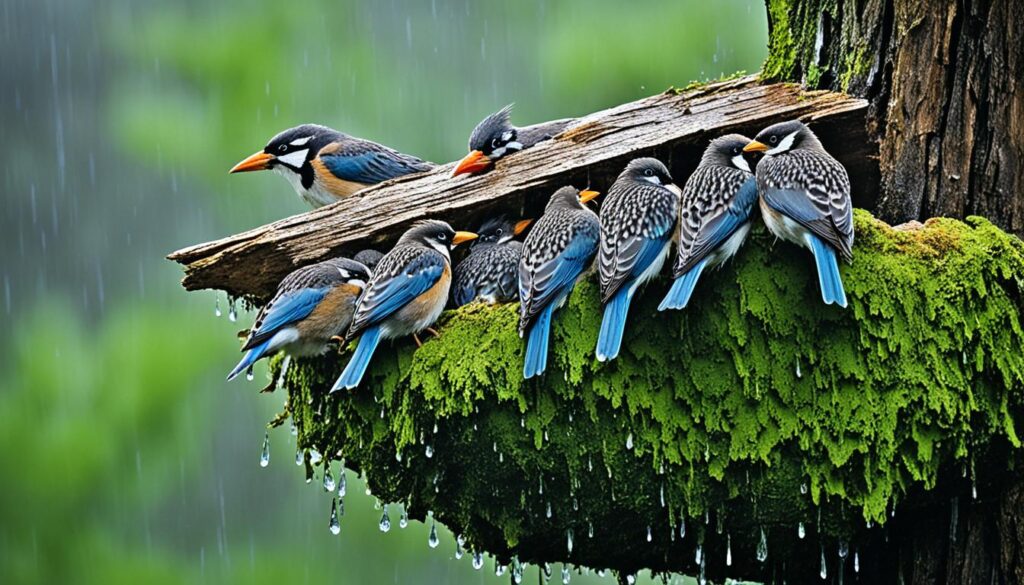
“Ecologists believe dead wood is one of the greatest resources for animal species in the forest.”
DIY Shelters for Birds
Homeowners can make simple DIY shelters for birds to protect them from rain and storms. These shelters mimic the natural debris and cover birds look for in the wild. They provide a safe place for birds to take refuge.
Building Brush Piles
Creating a brush pile is a simple DIY project. Stack logs, branches, and woody debris to make a dome-like shelter. Birds can use these refuges for protection. They also offer hiding spots and places to find food.
Rock Piles and Walls
Building rock piles or mini-rock walls is another DIY option. Use stones to create crevices and small caves. These structures provide shelter for birds during storms. They are like the natural nooks birds use in the wild.
Adding these easy features to your yard helps support local bird populations. It gives them the shelter they need during harsh weather. DIY bird shelter projects are a fun way to make your backyard a haven for birds.
“Providing simple, natural shelters for birds is one of the best ways to support their wellbeing and ensure they have a safe haven during storms and rain.” – The Backyard Naturalist
Roosting Boxes and Bat Houses
Homeowners can set up roosting boxes for birds to give birds a safe place during bad weather. These boxes have holes near the bottom to keep warm and let in birds. Bat houses do the same thing, giving shelter to bats and birds like bluebirds and chickadees. These artificial structures for bird storm protection help make backyards safe for birds.
Bat houses are key for helping endangered bat species. About 40 percent of U.S. and Canadian bats are at risk. The right design and placement of bat houses can make them more popular with bats. Houses for bats should be easy to reach and get lots of sun, especially in hot areas.
- Bat houses should be near water and 15-20 feet off the ground for best results.
- They need 6-10 hours of sun and should be put up in spring for bats to move in quickly.
- A single-chamber house can hold up to 50 bats, while bigger ones can house 200 or more.
By adding roosting boxes and bat houses, homeowners help protect these important birds and bats. With the right care, these structures become great for any bird-friendly yard.
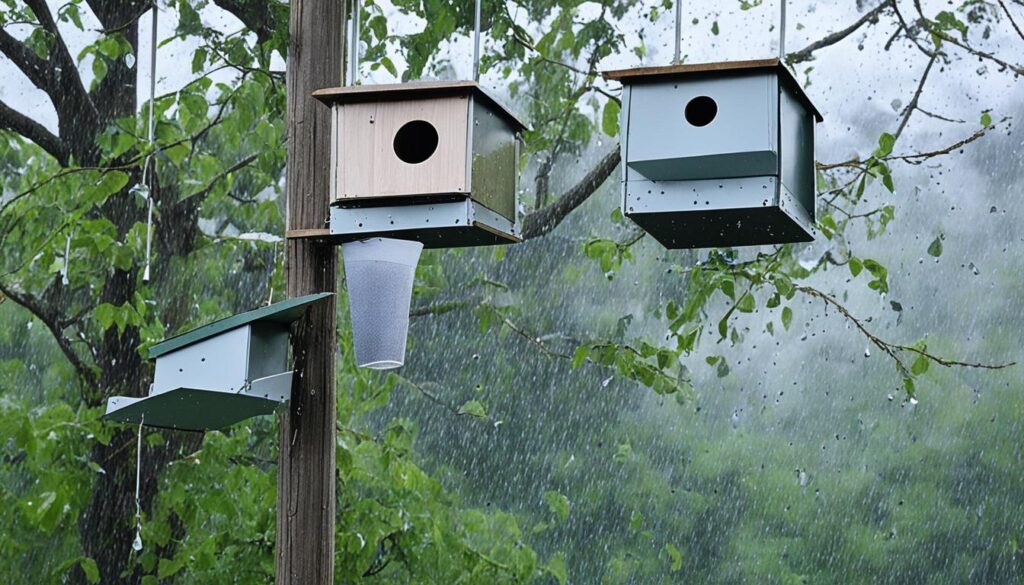
“Throughout the United States and Canada, there are occupied bat houses that are being used by various crevice-dwelling bat species.”
What do birds do when it rains?
When it rains, birds have many ways to stay dry and cozy. Their waterproof feathers and special oils help them stay dry. But, heavy rain can be tough, especially for small birds that lose heat fast.
Many birds avoid flying in heavy rain to keep warm. They hide in thick trees and bushes. Big birds like gulls and hawks just wait it out. Smaller birds find shelter under branches or leaning trunks to save energy.
Some birds keep foraging in light rain, even using it to take baths. But, big birds and waterfowl find flying hard in heavy rain. Their wings get wet, making them easy targets for predators.
To help birds in the rain, we can offer them special food like Feeder Fresh granules. We can also use Rain Away rain shields for feeders and sinkable roosting pouches for shelter. Moving feeders, using ground feeders with drains, and adding roosting boxes and bat houses helps birds stay dry.
“The more densely native plants are planted, the more protection they provide for wildlife and birds during rain or storms.”
Impact of Storms on Flight
Storms can make it hard for birds to fly well. Low air density and high humidity are common in severe weather. These conditions reduce lift and increase air resistance, making flying tough for birds. So, they often choose to perch and save energy instead of flying.
Low Air Density and Humidity
When storms have low-pressure centers, birds prefer to perch over flying. This is because the air is less dense due to rain or water vapor. With fewer air molecules, birds struggle to get the lift they need for flying. Also, the air’s moisture makes flying harder for them.
Perching and Conserving Energy
Perching is a smart move for birds in bad weather. It saves them from the strain of flying, which could tire or hurt them. Songbirds, for example, seek shelter during severe weather like hurricanes. This shows how they use instinct to stay strong until the storm goes away.
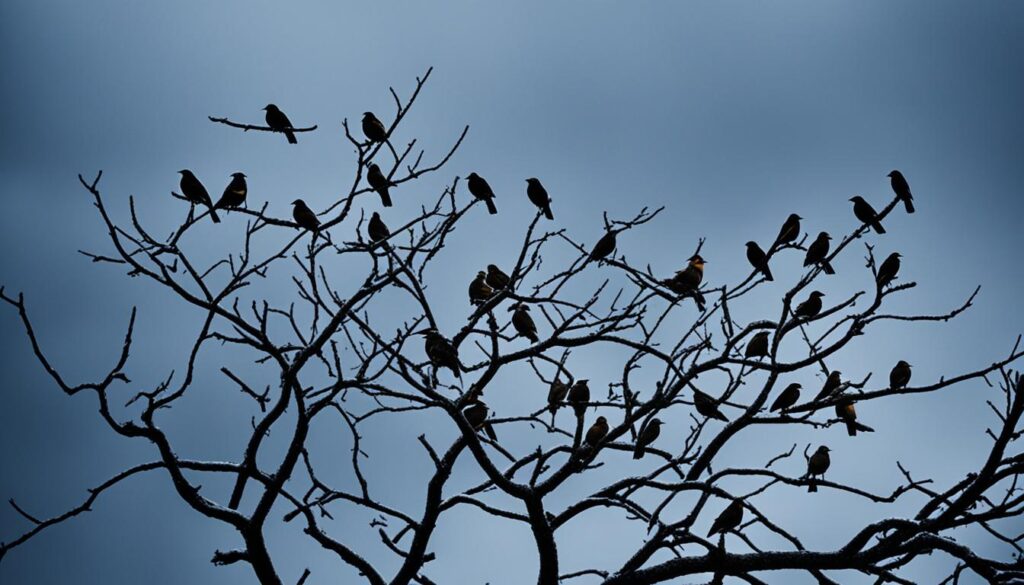
“Birds have amazing adaptations for dealing with bad weather. From waterproof feathers to strong perches, these traits show how well they’ve adapted over time.”
Storms affect bird flight in many ways, combining the environment with the birds’ biology and behavior. By learning about this, we see how birds have evolved to survive tough weather.
Roosting Habits by Bird Type
Birds have different ways of finding shelter during storms and heavy rain. Each type of bird has its own special way to stay safe. These methods help them survive bad weather.
Cavity Nesters
Cavity-nesting birds like chickadees and woodpeckers hide in their nest holes or roost boxes during storms. These spots protect them from the wind and rain. They also save energy when it’s cold and wet outside.
Perching Birds
Perching birds, including jays, sparrows, and cardinals, gather near tree trunks on the safest side. They find the best spots to hide from the wind and rain. This helps them stay safe during the storm.
Water Birds
Water birds, like ducks and herons, look for safe spots near plants or debris by the water. They avoid the worst of the weather but can still find food and places to rest.
Learning about how different birds find shelter during storms shows us their amazing survival skills. These strategies prove how resilient our bird friends are against changing weather.
Conclusion
Birds have many ways to handle rainy and stormy weather. They use their natural waterproofing and seek shelter instinctively. Whether they’re big birds or small songbirds, they’ve found ways to survive bad weather.
Learning how birds deal with the rain and storms helps us appreciate their survival skills. They can sense changes in air pressure and forage before storms hit. This shows their amazing ability to handle tough weather.
It’s important to give backyard birds a place to hide when it rains or storms. We can do this by planting native plants, making brush piles, and putting up roosting boxes. These actions help birds stay safe and happy, even when the weather is bad. By helping birds, we also make our yards and communities more beautiful and lively.
FAQ
What do birds do when it rains?
Birds have many ways to handle rainy weather. Their feathers and natural oils keep them mostly dry. But, they often avoid flying in heavy rain because it’s hard to fly. Instead, they hide in dense trees and shrubs to stay dry and save energy.
How do birds’ adaptations help them stay dry in the rain?
Birds’ feathers and special glands make them mostly waterproof. But, they still try to avoid flying in heavy rain. They fluff their feathers to trap air and keep warm. They also look for shelter in dense trees and shrubs to wait out the storm.
Where do birds go to find shelter when it rains?
Birds look for different shelters based on their size and where they live. Big birds like gulls and hawks just stay where they are. Smaller birds find shelter under thick leaves, tree trunks, and overhangs. Birds in cities might hide in buildings or sheds.
How do the rain response strategies differ between large and small birds?
Big birds like gulls and hawks just sit tight in heavy rain. Their size and feathers help them handle the rain. On the other hand, small birds hide under branches, leaning trunks, and thick leaves to stay dry and save energy.
How do urban birds find shelter when it rains?
Urban birds have more places to hide when it rains. They use buildings, sheds, and other man-made spots for shelter. Along with these, they also look for natural spots in trees and shrubs.
How do birds in rainy climates cope with frequent precipitation?
Birds in rainy places get used to the wet weather. They still look for shelter in heavy rain but keep doing their daily activities in light rain. They have ways to deal with the rain in their homes.
What do birds do when a storm is approaching?
Birds can feel changes in air pressure before a storm comes. They start to gather food, getting ready for the bad weather. When the storm hits, they hide in thick plants, holes, and other safe spots to wait for it to pass.
Where do birds find shelter during intense storms?
In strong storms, birds hide in the thickest plants they can find. They also go to the downwind side of forests for protection from the wind and rain. These spots help them stay safe and save energy until the storm ends.
How do cavity-nesting birds fare during storms?
Birds that live in holes, like chickadees and woodpeckers, do well in storms. They stay in their nests or roost boxes to avoid the wind and rain. This keeps them safe and helps them save energy.
How can homeowners provide shelter for birds during rain and storms?
Homeowners can help birds by planting lots of native plants. These plants provide important shelter. They should also keep dead trees, which birds use for shelter and nesting.
Why are dead trees and snags important for birds during storms?
Dead trees, or snags, are good for birds. They decay and lose branches, making cavities for shelter. Woodpeckers also make their homes in these trees. This gives birds more places to hide during bad weather.
What other DIY shelters can homeowners create for birds?
Homeowners can make simple shelters for birds. They can stack logs and branches to make a dome-like shelter. They can also pile rocks to create hiding spots. These things help birds find the cover they need in the wild.
How can specialized roosting boxes and bat houses provide shelter for birds?
Homeowners can also put up special boxes for birds. These boxes have holes for warmth and let many birds hide together. Bat houses work the same way, giving shelter to birds like bluebirds and chickadees. These boxes help make bird-friendly backyards.
How do storms impact a bird’s ability to fly?
Storms make it hard for birds to fly because of the low air and high humidity. It’s tough for them to fly, so they often just perch and save their energy. This helps them get through the tough weather.
What are the different roosting habits and sheltering strategies of various bird species?
Birds have different ways to find shelter based on what they are and where they live. Some birds hide in holes or boxes. Others perch near tree trunks. Water birds find shelter near plants or debris by the water. These behaviors help them survive storms and heavy rain.
